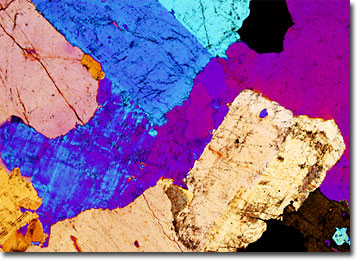Polarized Light Microscopy Digital Image Gallery
Biotite Hornblende Granite
Granite is a medium- to coarse-grained igneous rock that has been utilized for construction and sculpture for thousands of years. It is chiefly composed of feldspars and quartz, but also frequently contains small amounts of hornblende and micas, such as biotite.

Not only is hornblende often found in granite, but also in syenite, gabbro, basalts, gneisses, schists, and a wide array of other rock types. The calcium-rich amphibole, which generally ranges in color from a pure green to greenish-black, usually develops as short, thick prismatic crystals. It may also occur, however, in granular or fibrous forms, sometimes in massive deposits. Also, a type of hornblende called edenite, in which iron oxides comprise less than 5 percent of the chemical makeup, appears in significantly lighter hues of gray or white. Of little practical use, hornblende has negligible commercial value.
Sometimes known as black mica, biotite may be found in any type of granite and is almost always present, though sometimes in miniscule quantities. The common silicate mineral is also often a component in metamorphic rocks, pegmatites, and other intrusive igneous rocks. As its alternate name implies, biotite is typically black in color, but it may also occur in dark brown hues. Similar to other micas, the mineral exhibits a layered structure and perfectly cleaves into thin, flexible sheets. When it weathers, biotite lightens in color, appearing a shiny, metallic yellow that is sometimes mistaken for gold.
